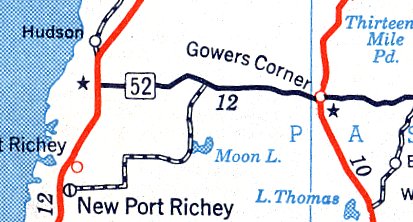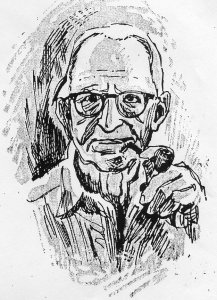Your cart is currently empty!

RAO MUSUNURU, M.D. MUSEUM & LIBRARY
HISTORY OF PASCO COUNTYGower’s Corner
Left: Detail from a 1953 Standard Oil Florida road map; right: W. A. Gower. Some pictures of Gowers Corner are here. More about Gower is in the 1988 article, “Sawmill Town Went From Boom to Bust,” here. A photo of William A. Gower and his wife Daisy at findagrave.com is here. This page was last revised on July 6, 2020. Gowers Corner, originally Gower’s Corners, was named for owner William Arthur Gower, who had been superintendent at the Aripeka Sawmills at Fivay. Citrus, Sawmills, Critters, & Crackers has:
According to Jeff Cannon, property records indicate that Gower did not build the grocery store and that the 80 acres referred to above are actually located south of the corners. The name Gower’s Corner is found in the Tampa Tribune on Nov. 14, 1934. In 1936 the Pasco County Tax Assessor included in his itinerary Gower’s at Fivay Junction. In 1937 he included in his itinerary Gowers Corner at Greenfield. Gower himself gave Greenfield as the location of his business. A 1994 Tampa Tribune article about some of the newspaper’s long-time readers reported that Ralph Gower, then age 90, moved with his family to Ballast Point in 1911. The article also has: “Gower’s father, a lumberman, had moved the family to Fivay, Fla. in the early 1900s to work at a sawmill. When they moved to Ballast Point a year later, however, they quickly realized Tampa was not another sawmill town.” In the 1970s, before the government center was built in New Port Richey, there was discussion of building a government complex at Gowers Corner, or even changing the county seat from Dade City to Gowers Corner. On April 30, 2016, the Tampa Tribune reported:
Gowers Corner: Tiny Community With Big TraditionBy JOSEPH A. SULLIVAN This article appeared in the Tampa Tribune, date unknown. GOWERS CORNER — No one is sure when this central Pasco County village got its name, but townsfolk say it has a “Peyton Place” legend and was named for a man who carried an ax handle and a tear gas canister for protection and to keep peace. Gowers Corner, carved around the intersection of U. S. 41 and S. R. 52, was named for W. A. Gower, a small man who owned a sawmill and operated a service station at the southeast corner of S. R. 52. In fact, he owned all four corners of the intersection. Gower, now in his 90s and living in a Tampa nursing home, is almost a legend here similar to the legendary figures of the Old West. When he started his business at the crossroads, Pasco, with its cattle interests, resembled the Old West. Back in the 1920s what was to become Gowers Corner was a spot on a state highway that passed through a sparsely populated county. What population there was centered on either side of the county about 20 miles away. And 20 miles in those days wasn’t the short drive it is today. So a man was virtually on his own having to depend largely on himself for protection. “Mr. Gower hated people who’d cause trouble at his gas station,” townsfolk recall. “He was always suspicious of strangers.” When trouble did occur, “Quick as lightning, Mr. Gower would swing the ax handle or pull the gas canister out of his pocket and shoot straight for the eyes.” But residents also remember Gower was “an excellent human being, a decent man who was nice to his neighbors.” All the descriptions together make up the local folklore or legends about the man whose name the village now bears. Estimates vary as to when the unincorporated town actually took the name Gowers Corner. Jim Williams, 79, a local resident and still an active cattleman, estimates the date was about 1925. Just what encompasses “Gowers Corner” today is somewhat a mystery. J. W. Chapman, who now owns the service station Gower once ran and operates a grocery-sundry store inside the station, says the few businesses her do well. He gets furious when the town is called a “no man’s land.” “I’ve been running this service station for 20 years,” he says, “and I’ll wager that each day we get 30,000 cars on U. S. 41 and 20,000 on S. R. 52.” “Gowers Corner is anything but a ‘no man’s land’,” Chapman insists, speculating that the community eventually may be incorporated but conceding that probably no 2 people can agree where the town begins and where it ends. Some believe the 4 intersection corners comprise Gowers Corner, but others, including Chapman and Virgil Williams, argue there’s more to the old sawmill town than the 4 corners. “The way I see it,” says Williams, “Gowers Corner extends a couple of miles or so from the intersection in all directions.” There’s nothing resembling a consensus, either, on the number of people who live in this crossroads hamlet 27 miles north of Tampa, in the geographic of the county. Estimates range from 250 to 1,200. Virgil Williams and his brother, Jimmie, sons of Jim Williams, own the big crossroads sawmill on S. R. 52, just west of U. S. 41. They sell lumber throughout the Tampa Bay area and say business is booming. Jimmie Williams agrees with most residents that conventional traffic signals should be installed at the Gowers Corner intersection, scene of many vehicular deaths and injuries through the years. But Virgil Williams favors a S.R. 52 overpass, fearing that some of the many rock trucks that travel U. S. 41 would roll through the red lights. He concedes, though, that chances of getting a costly overpass are slim. Virgil Williams, 48, readily acknowledges there’s more truth than fiction to stories old-timers tell about scandalous romances here and savage brawls at redneck bars. In those days, there were few women and many men, Williams says, so men would fight over the women. “It wasn’t all that long ago,” he laughs. “I know for certain there were some hot times up till a few years ago. There were knock-down, drag-out bar fights most every Saturday night.” “And Peyton Place! Well, there was a time when Gowers Corner would’ve made Peyton Place seem like a kindergarten.” |

